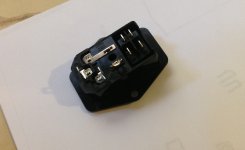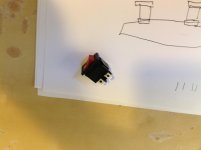I grabbed this at the local surplus... And am just wanting to make sure this will work for my gainclone I am building.
It says "use only with a 250v fuse" on the door, but the guy at the shop said it was just a max rating, and this would work for my intended application.
The illumination I don't care for, and am hoping it can be bypassed and used as a switch only, sans light. So here are some photos:
It says "use only with a 250v fuse" on the door, but the guy at the shop said it was just a max rating, and this would work for my intended application.
The illumination I don't care for, and am hoping it can be bypassed and used as a switch only, sans light. So here are some photos:
Attachments
That will make a good fused mains input connector. you don't need to use the illumination if you don't want it. The switch looks as if it pops out, so you can take the neon out of it or just use it as a single pole switch switching the live of course!
I don't think the switch pops out, nor am I sure how to remove the neon. Starting to wish they just had the unlit ones haha.
So using a 250v unit in 120v environment is fine, I assume these fuses are smaller? The ones in my speakers are 125v, so naturally they are too big for the drawer, and am not sure of the type of fuse I will need, hence my concern.
So the size is smaller than my other fuses, but I use a 125v fuse, correct? This seems most logical to me, but Mr. Spock I am not... I always question my logic - especially when it comes to AC mains.
Edit... Got it out... I see leads for an LED or sth...
So using a 250v unit in 120v environment is fine, I assume these fuses are smaller? The ones in my speakers are 125v, so naturally they are too big for the drawer, and am not sure of the type of fuse I will need, hence my concern.
So the size is smaller than my other fuses, but I use a 125v fuse, correct? This seems most logical to me, but Mr. Spock I am not... I always question my logic - especially when it comes to AC mains.
Edit... Got it out... I see leads for an LED or sth...
Attachments
Last edited:
If its the type I think then it takes a standard 5 x 20mm fuse in the draw. Voltage ratings up to a maximum of 250V. As long as the fuse is suitably rated - in a 120v system then 120v fuses are fine as are higher voltage rated ones. The Amp rating is the protection offered 😉
the switch is double pole with "usually" a neon across the poles. If you use one side only as a single pole switch then the neon will be off or if the wires are accessible then cut them and use as a double pole.
Given this is normally on the back of equipment there is probably no need to disable the light. and a 250V neon will be feeble on 120V.
the switch is double pole with "usually" a neon across the poles. If you use one side only as a single pole switch then the neon will be off or if the wires are accessible then cut them and use as a double pole.
Given this is normally on the back of equipment there is probably no need to disable the light. and a 250V neon will be feeble on 120V.
- Status
- Not open for further replies.

